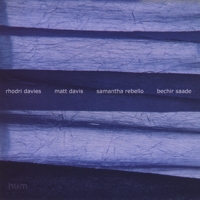| Hum Rhodri Davies - harp & objects |
“On a first casual listen I seriously undervalued this disc. Many of the microdynamics with which it works were lost on me. But after a couple of more careful listens I could appreciate the truly high quality of this music. It’s certainly not one to listen to in a rush. This is a concentrated music exploring the essence of sounds, certainly reductionist, but not extremely so. Or better, it’s a musical process which moves forward in little jumps and spurts, and is subtly frenetic. A strange kind of beauty moves within hum: that of a microworld shifting ceaselessly through phases of construction, collapse and reconstruction. A world of squeaks and small shrieks, of gusts of breath and mournful laments, and of fragments of detritus which blow around and then dissolve in every corner. Most of the cd has a kinetic vibrancy, little sonic structures emerge and build up with a vague energy, then are suddenly abandoned before their potential has become exhausted in inertia. In the midst of these alternating phases of construction and collapse, hidden behind apparently empty spaces, small movements occur and are picked out by a faint light. Then sometimes the music abandons itself to moments of extreme introspection as the wind instruments produce sounds of abstract melancholy, and impromptu drones, thanks mainly to Rhodri Davies, revolve and then slowly evaporate.” - Alfio Castorina, Kathodik webzine Buy this album now CD: £10.00+ p&p |
| Please click here for other recordings by Rhodri Davies |
| TRACKS | ||
| 1 | one | 07:12 |
| 2 | two | 13:26 |
| 3 | three | 08:02 |
| 4 | four | 07:17 |
| 5 | five | 06:13 |
| Total Time | 42:46 | |
Recorded by Graham Halliwell at the Red
Rose Club, London on 23rd June 2007
Produced & Mastered by Simon Reynell
Design : grayscaling@hotmail.com
Another Timbre,
70 High Storrs Road,
Sheffield,
England, S11 7LE
“ ‘Hum’ relaunches the quest for new expressive methods in that area of EAI which mainly deals with constituents such as air, saliva, friction. The instrumentation makes for some pretty damn fine moments of fascinating interaction, with Matt Davis’ electronics often constituting an element of menacing doubt amidst a detailed suspension characterized by various types of overtones that peep first, clash later, then look for a meeting point somewhere in the middle. “Two” wears the timbral components down to frazzles, giving the music a far-reaching anxiousness miles away fromself-indulgence. On the contrary the music takes advantage of the whole dynamic range to uproot any hope from those who expect vibrations of peace and love to sweeten an improvisation.
It’s virtually impossible to quantify
individual contributions to the body of the performance, despite the
extreme clarity of the recording. While breath is obviously a common
denominator - although fragmented to minuscule crumbles, oppressive
exhalations and guttural snaps - it is when Davies’ harp resonates
vigorously that the music assumes a totally different weight, transforming
the seductive, if somehow acrid grace of Rebello and Saade’s microscopic
elaboration into a muscular buzzing torso that David Jackman would almost
envy. Tracks like “One” and “Four” bring
us back to the golden era of reductionism, but the tendencies
to silence are soon removed in favour of gentle droning and mechanical
tampering amidst piercing shrieks and malevolent low-tone resurgences. A
distinct urban cloud underlines the seagull-like harmonics at the beginning
of “Five”, scraped strings and scattered noises dematerialising
pigmentations and suggestions down to a combustible absence of meaning.”
Massimo Ricci, Touching
Extremes
“It’s odd to think that the micro-gestural sound world of musicians such as these now have a deep tradition on which to draw. Improvisers have been mining the lower boundaries of dynamics, and densities for long enough that the vocabulary and strategies are no longer the radical affront they once appeared to be. Today's listeners are attuned to the flickers, breaths, scrapes, and hisses to the point that they can get past the surface textures of extended technique and focus on the music that is being created. Rhodri Davies and Matt Davis are both well-established improvisers in settings like this. For Hum they are joined by flutist Samantha Rebello and bass clarinetist Bechir Saade for a series of intimately detailed collective sound explorations. While Rebello is a new name, Saade is a member of the Lebanese improv scene along with Sharif Sehnaoui, Christine Sehnaoui, and Mazen Kerbaj. The instrumentation is harp, trumpet and electronics, flute, and bass clarinet but of course that does little to describe the music. Instead, what jumps out is a strategy of collective circumspection as the four assiduously construct spontaneous tracery. There is the clear weighting of sound and space; durations of tone placed against scrubbed and scraped textures; velocity of activity balanced with inky stasis. While electronics are present, their use is understated, placing a much stronger focus on the acoustic interactions. Fluttering breaths, sputtered reed pops, bowed and scraped strings, strident flute overtones, and brassy exhales, buzzes, and valve clicks create a taught balance of density and transparency. Their palate and attack eschews line for more of a sense of collective sonic choreography and it is here that they really develop their group sound. For all the subtleties, this is not about muted silence. Instead the four have woven together improvisations full of variegated lucidity informed by careful listening and radiant interaction.”
Michael Rosenstein, Signal to Noise
